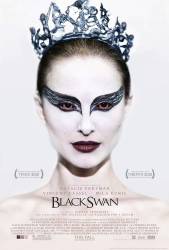Continuity mistake: When Nina and Leroy are standing halfway up the stairs as he is about to announce that she is the new star ballerina, they both hold a glass of champagne. At first, Nina's glass is almost empty; at the end of the scene however, she is holding a full glass.
Continuity mistake: We see Nina put on red lipstick on the subway. In the next scene, when she's in the studio, her lips are skin-colored, implying that the lipstick is off. But when she enters the director's office, the lipstick is on again, even though she never reapplied it.
Continuity mistake: When Nina watches Lily dancing after filling up her water bottle, look very closely at Lily's back as she spins around and you can see that her tattoo isn't there. As she was wearing a vest and her hair was down over her back, it is likely the film makers thought they could get away with this.






Answer: **Spoiler Alert** I would say you are correct about the movie being a metaphor for descent into madness, but also displays themes of repressed sexuality and transformation. As the main character is given the lead role, she must play dual roles, one good and one evil, with the hallucinations representing the latter. Towards the beginning, Nina only embodies the personality traits of the white swan, innocence and grace. As the film gradually progresses, Ninas hallucinations represent her metamorphosis into the seductive and mysterious black swan. The film expertly convinces the audience that Lily (Mila Kunis) is out for Nina's role. In a twist ending, it is revealed that Nina has imagined most of her encounters with lily (including their sexual one) and has instead been battling herself, such as breaking away from her domineering mother and coming to terms with her sexuality. At the end, Nina really does stab herself (but actually hallucinates it is Lily she is stabbing) and her fate is left ambiguous.